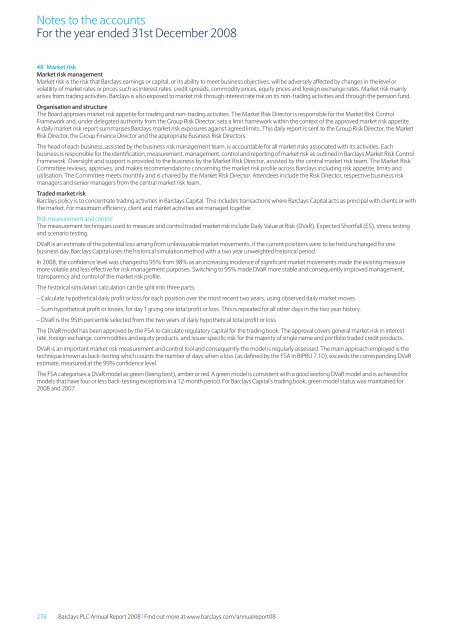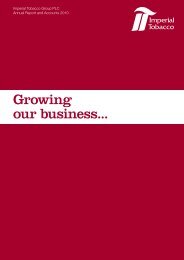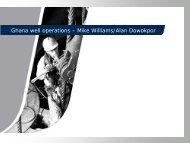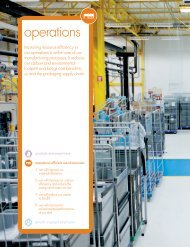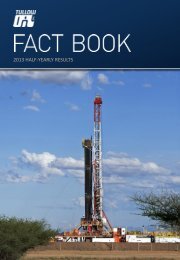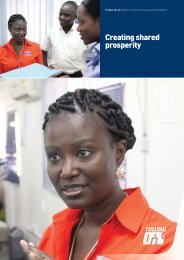Barclays plc - Annual Report 2008 - Financial statements - The Group
Barclays plc - Annual Report 2008 - Financial statements - The Group
Barclays plc - Annual Report 2008 - Financial statements - The Group
Create successful ePaper yourself
Turn your PDF publications into a flip-book with our unique Google optimized e-Paper software.
Notes to the accounts<br />
For the year ended 31st December <strong>2008</strong><br />
48 Market risk<br />
Market risk management<br />
Market risk is the risk that <strong>Barclays</strong> earnings or capital, or its ability to meet business objectives, will be adversely affected by changes in the level or<br />
volatility of market rates or prices such as interest rates, credit spreads, commodity prices, equity prices and foreign exchange rates. Market risk mainly<br />
arises from trading activities. <strong>Barclays</strong> is also exposed to market risk through interest rate risk on its non-trading activities and through the pension fund.<br />
Organisation and structure<br />
<strong>The</strong> Board approves market risk appetite for trading and non-trading activities. <strong>The</strong> Market Risk Director is responsible for the Market Risk Control<br />
Framework and, under delegated authority from the <strong>Group</strong> Risk Director, sets a limit framework within the context of the approved market risk appetite.<br />
A daily market risk report summarises <strong>Barclays</strong> market risk exposures against agreed limits. This daily report is sent to the <strong>Group</strong> Risk Director, the Market<br />
Risk Director, the <strong>Group</strong> Finance Director and the appropriate Business Risk Directors.<br />
<strong>The</strong> head of each business, assisted by the business risk management team, is accountable for all market risks associated with its activities. Each<br />
business is responsible for the identification, measurement, management, control and reporting of market risk as outlined in <strong>Barclays</strong> Market Risk Control<br />
Framework. Oversight and support is provided to the business by the Market Risk Director, assisted by the central market risk team. <strong>The</strong> Market Risk<br />
Committee reviews, approves, and makes recommendations concerning the market risk profile across <strong>Barclays</strong> including risk appetite, limits and<br />
utilisation. <strong>The</strong> Committee meets monthly and is chaired by the Market Risk Director. Attendees include the Risk Director, respective business risk<br />
managers and senior managers from the central market risk team.<br />
Traded market risk<br />
<strong>Barclays</strong> policy is to concentrate trading activities in <strong>Barclays</strong> Capital. This includes transactions where <strong>Barclays</strong> Capital acts as principal with clients or with<br />
the market. For maximum efficiency, client and market activities are managed together.<br />
Risk measurement and control<br />
<strong>The</strong> measurement techniques used to measure and control traded market risk include Daily Value at Risk (DVaR), Expected Shortfall (ES), stress testing<br />
and scenario testing.<br />
DVaR is an estimate of the potential loss arising from unfavourable market movements, if the current positions were to be held unchanged for one<br />
business day. <strong>Barclays</strong> Capital uses the historical simulation method with a two year unweighted historical period.<br />
In <strong>2008</strong>, the confidence level was changed to 95% from 98% as an increasing incidence of significant market movements made the existing measure<br />
more volatile and less effective for risk management purposes. Switching to 95% made DVaR more stable and consequently improved management,<br />
transparency and control of the market risk profile.<br />
<strong>The</strong> historical simulation calculation can be split into three parts:<br />
– Calculate hypothetical daily profit or loss for each position over the most recent two years, using observed daily market moves.<br />
– Sum hypothetical profit or losses, for day 1giving one total profit or loss. This is repeated for all other days in the two year history.<br />
– DVaR is the 95th percentile selected from the two years of daily hypothetical total profit or loss.<br />
<strong>The</strong> DVaR model has been approved by the FSA to calculate regulatory capital for the trading book. <strong>The</strong> approval covers general market risk in interest<br />
rate, foreign exchange, commodities and equity products, and issuer specific risk for the majority of single name and portfolio traded credit products.<br />
DVaR is an important market risk measurement and control tool and consequently the model is regularly assessed. <strong>The</strong> main approach employed is the<br />
technique known as back-testing which counts the number of days when a loss (as defined by the FSA in BIPRU 7.10), exceeds the corresponding DVaR<br />
estimate, measured at the 99% confidence level.<br />
<strong>The</strong> FSA categorises a DVaR model as green (being best), amber or red. A green model is consistent with a good working DVaR model and is achieved for<br />
models that have four or less back-testing exceptions in a 12-month period. For <strong>Barclays</strong> Capital’s trading book, green model status was maintained for<br />
<strong>2008</strong> and 2007.<br />
278 <strong>Barclays</strong> PLC <strong>Annual</strong> <strong>Report</strong> <strong>2008</strong> | Find out more at www.barclays.com/annualreport08


